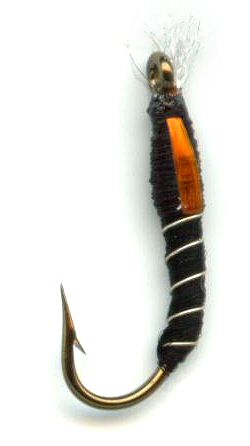Orange Cheeked Black Buzzer Midge Larvae Nymph
Why are buzzer midge nymph patterns covered in epoxy glue? I believe the most important reason is that they give the fly a very smooth finish that helps it slice through water to get to the required depth quickly without making a bug splash.

BUZZER MIDGE FLY PATTERNS. Hook size 12 14 16 18 20 24 - $US each
It offers less resistance than other nymph patterns and has a faster sink rate. The epoxy also adds weight to the fly which helps with the decent. The glue forms a hard outer coating and as a result makes it much more durable than other nymphs. The trout’s teeth can make short work of fine ribbing and bare thread found on other nymph patterns.
Epoxy Buzzers are, for these reasons, very useful as point flies, as they can get down through the water to the depth required fast and act as an anchor for the rest of the team. The natural insects are often observed having a sheen appearance to their outer surface as they rise in the water column. This is caused by microscopic air bubbles which often appear as the pupae becomes active. The shiny appearance of the outside of an epoxy buzzer imitates this condition visually and fools trout and grayling.
The New Zealand Dropper Rig and epoxy Chironomid buzzers
So what sort of fly fishing rig is the most productive during a hatch? Nymphs are rising to hatch and duns are emerging on the water surface. Should you concentrate on all the subsurface activity or ignore it and just fish dry flies? If you do not want to put all your eggs in one basket then use the New Zealand dropper rig.
A nymph is put on point below a dry fly pattern. This is particularly effective when the hatch is sparse. This way you will be making the most out of the event. You should be in a position to catch trout looking for rising nymphs and also those cruising the surface looking to sip at emerging mayflies that are waiting for their wings to dry. My choice for the point fly would be a large epoxy buzzer as it weight and slime smooth design helps get the rig down fast and acts like an anchor. Your dry fly should match the hatch in shape color and size. I sometimes like to add a soft hackled spider wet fly on a middle as the long hackles look like the legs on an ascending nymph as they try to help it swim to the surface.
Buzzer tips
When river fishing for trout with teams of buzzers nymph fly patterns on the end of my rod I have had success inducing takes by directly raising the buzzer by simply lifting the fishing rod tip. This imparts a natural movement in the artificial as if it gave a small tweak then rested. This technique can be very effective at close range but at longer distance it has the reverse effect as it makes the nymph move un-naturally fast in the water flow. These buzzer nymphs are not fast swimmers. If your artificial fly suddenly develops superpowers it will scare off lurking trout.
What you can do is try to get closer to your prey by stalking along the river bank. Stay low, use natural trees, bushes and bankside vegetation to hide your approach. Do not wear bright clothing. If the water is not too deep wade closer slowly. This type of fishing requires extreme patience and stealth. Use a longer rod to improve your control over a greater distance.


